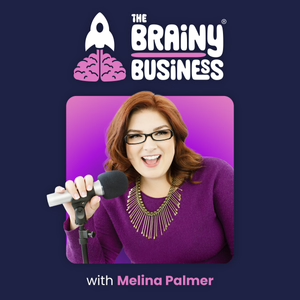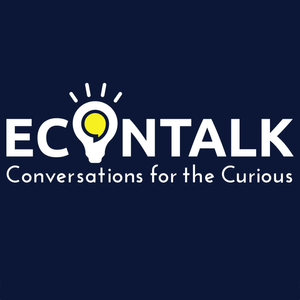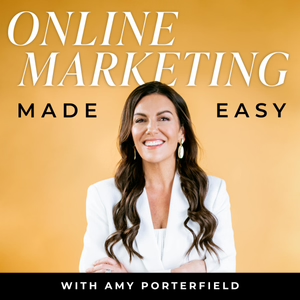
35. NUDGES & Choice Architecture: Introducing Nobel-Winning Concepts
02/15/19 • 36 min
1 Listener
Nudges and choice architecture are complex and advanced topics. During my master's program, I had an entire course on choice architecture, so I'm going to break down this foundational topic into a series. Today's behavioral economics podcast is an introduction to nudges and choice architecture. In each episode, I’ll share the concept and then give real life examples to illustrate that concept.You’re a choice architect whether you realize it or not, and honestly whether you want to be or not. So, it is best to understand the concepts. Don’t you owe it to the people you are presenting choices to? Wouldn’t you want someone in your same position to help you to make the best possible choice? This series is going to help you so much in your life and business both when you are making choices and when you are constructing them for others.
CLICK HERE FOR YOUR FREE DOWNLOAD!Show Notes
- [03:29] In its most core definition, a nudge is a gentle touch or tap.
- [04:37] An example of nudges in a school cafeteria where rearranging the food items impacted their consumption by 25%. A prominent position can increase consumption by 25% and a less prominent position can decrease consumption by 25%.
- [06:55] An excerpt from Nudge which outlines the dilemma of where how to structure the food in the cafeteria: 1. Arrange the food to make the students best off, all things considered. 2. Choose the food order at random. 3. Try to arrange the food to get the kids to pick the same foods they would choose on their own. 4. Maximize the sales of the items from the suppliers that are willing to offer the largest bribes. 5. Maximize profits, period.
- [07:50] Option 1 has obvious appeal, yet it does seem a bit intrusive.
- [08:25] Option 2, arranging the food at random, could be considered fair-minded and principled.
- [08:55] Option 3 might seem to be an honorable attempt to avoid intrusion (but the test shows why this is flawed).
- [09:44] Option 4 might appeal to a corrupt person in the job (not us).
- [10:02] Option 5 has some appeal, especially if we think the best cafeteria is the one that makes the most money.
- [10:22] What would you choose? How would you choose? This, is the burden of the choice architect. Many of you are already choice architects and you might not even realize it.
- [11:15] There are many parallels between choice architecture and more traditional forms of architecture. A crucial parallel is that there is no such thing as a “neutral” design.
- [12:33] Small and apparently insignificant details can have major impacts on people’s behavior. A good rule of thumb (as you have heard me say many, many times before) is to assume that “everything matters”
- [13:16] A choice architect must choose a particular arrangement of the food options for lunch (or whatever choice they are facilitating) and by doing so we can influence what people eat. We can nudge.
- [13:39] “A nudge is any aspect of the choice architecture that alters people’s behavior in a predictable way without forbidding options or significantly changing their economic incentives."
- [14:15] Some of the key takeaways from the paraphrased explanation are: 1. Everything matters 2. There are no neutral options 3. You cannot avoid being a choice architect – any format is influencing the choices, so it is best to be informed 4. Nudges can help simplify complex choices and help illogical humans make good choices 5. Nudges are not mandates – they need to be easily avoidable to still count as a nudge.
- [15:02] Choice architecture and nudges are very closely tied – but they are not the same thing.
- [15:12] A choice architect is someone who indirectly influences the choices of other people. The choice architecture is the mechanism you use to facilitate the choices.
- [15:26] A nudge is something you would use to influence the decision.
- [16:21] An example of the concepts using an HR department: You want to structure choices on a form to help encourage employees to contribute to their retirement account.
- [18:21] The first item on the list will have the most weight on the brain. It's best to put the recommendation first (a nudge).
- [19:28] Different wording has different results. Consider saying something like: “Experts recommend contributing 15% of your salary to a 401k, how much would you like to allocate?” (and how it differs from other verbiage)
- [19:49] This example includes framing, priming, and anchoring and adjustment.
- [23:39] For your options, you can include several positive options (which start with the word “yes”) and then one “no” option at the bottom. These nudgy options remind the user of the expert recommendations. You can also prime them to contribute at a later time.
- [24:21]...
Nudges and choice architecture are complex and advanced topics. During my master's program, I had an entire course on choice architecture, so I'm going to break down this foundational topic into a series. Today's behavioral economics podcast is an introduction to nudges and choice architecture. In each episode, I’ll share the concept and then give real life examples to illustrate that concept.You’re a choice architect whether you realize it or not, and honestly whether you want to be or not. So, it is best to understand the concepts. Don’t you owe it to the people you are presenting choices to? Wouldn’t you want someone in your same position to help you to make the best possible choice? This series is going to help you so much in your life and business both when you are making choices and when you are constructing them for others.
CLICK HERE FOR YOUR FREE DOWNLOAD!Show Notes
- [03:29] In its most core definition, a nudge is a gentle touch or tap.
- [04:37] An example of nudges in a school cafeteria where rearranging the food items impacted their consumption by 25%. A prominent position can increase consumption by 25% and a less prominent position can decrease consumption by 25%.
- [06:55] An excerpt from Nudge which outlines the dilemma of where how to structure the food in the cafeteria: 1. Arrange the food to make the students best off, all things considered. 2. Choose the food order at random. 3. Try to arrange the food to get the kids to pick the same foods they would choose on their own. 4. Maximize the sales of the items from the suppliers that are willing to offer the largest bribes. 5. Maximize profits, period.
- [07:50] Option 1 has obvious appeal, yet it does seem a bit intrusive.
- [08:25] Option 2, arranging the food at random, could be considered fair-minded and principled.
- [08:55] Option 3 might seem to be an honorable attempt to avoid intrusion (but the test shows why this is flawed).
- [09:44] Option 4 might appeal to a corrupt person in the job (not us).
- [10:02] Option 5 has some appeal, especially if we think the best cafeteria is the one that makes the most money.
- [10:22] What would you choose? How would you choose? This, is the burden of the choice architect. Many of you are already choice architects and you might not even realize it.
- [11:15] There are many parallels between choice architecture and more traditional forms of architecture. A crucial parallel is that there is no such thing as a “neutral” design.
- [12:33] Small and apparently insignificant details can have major impacts on people’s behavior. A good rule of thumb (as you have heard me say many, many times before) is to assume that “everything matters”
- [13:16] A choice architect must choose a particular arrangement of the food options for lunch (or whatever choice they are facilitating) and by doing so we can influence what people eat. We can nudge.
- [13:39] “A nudge is any aspect of the choice architecture that alters people’s behavior in a predictable way without forbidding options or significantly changing their economic incentives."
- [14:15] Some of the key takeaways from the paraphrased explanation are: 1. Everything matters 2. There are no neutral options 3. You cannot avoid being a choice architect – any format is influencing the choices, so it is best to be informed 4. Nudges can help simplify complex choices and help illogical humans make good choices 5. Nudges are not mandates – they need to be easily avoidable to still count as a nudge.
- [15:02] Choice architecture and nudges are very closely tied – but they are not the same thing.
- [15:12] A choice architect is someone who indirectly influences the choices of other people. The choice architecture is the mechanism you use to facilitate the choices.
- [15:26] A nudge is something you would use to influence the decision.
- [16:21] An example of the concepts using an HR department: You want to structure choices on a form to help encourage employees to contribute to their retirement account.
- [18:21] The first item on the list will have the most weight on the brain. It's best to put the recommendation first (a nudge).
- [19:28] Different wording has different results. Consider saying something like: “Experts recommend contributing 15% of your salary to a 401k, how much would you like to allocate?” (and how it differs from other verbiage)
- [19:49] This example includes framing, priming, and anchoring and adjustment.
- [23:39] For your options, you can include several positive options (which start with the word “yes”) and then one “no” option at the bottom. These nudgy options remind the user of the expert recommendations. You can also prime them to contribute at a later time.
- [24:21]...
Previous Episode

34. Optimism Bias: The Good And The Bad Of Those Rose-Colored Glasses
Today’s behavioral economics foundations episode is all about the optimism bias. I hope you’ve got your rose colored glasses, because here we go! This is one of those topics that has a name that makes it seem like you MIGHT know what it is...but you potentially don’t know for sure...and you probably don’t realize how much it impacts you and your customers every day.
So, what is optimism bias? Essentially, this is our tendency to overweight the likelihood good things will happen to us, and underestimate the likelihood bad things will happen to us. This episode explores why we think this way and how understanding optimism bias can be used to improve our businesses.
CLICK HERE FOR YOUR FREE DOWNLOAD!Show Notes
- [05:25] OPTIMISM BIAS - This is one of those topics that has a name that makes it seem like you MIGHT know what it is...but you potentially don’t know for sure...and you probably don’t realize how much it impacts you and your customers every day.
- [05:31] This is our tendency to overweight the likelihood good things will happen to us, and underestimate the likelihood bad things will happen to us.
- [06:34] It is important to note that optimism bias is not the same as being an optimist. And, if you consider yourself to be a pessimist or a realist...it doesn’t mean that you are not impacted by the optimism bias. It just might impact you a little bit differently.
- [07:08] Marriage is a great example of optimism bias. In spite divorce statistics, no one thinks that they are going to get divorced when they get married.
- [07:57] According to the CDC, 1 in every 4 deaths is due to heart disease, claiming 610,000 lives each year. Do you think the statistic will affect you? Your spouse? Parents? Close friends? Probably not.
- [08:36] We also think our children are uniquely talented and skilled – that they will grow up to change the world and do amazing things.
- [09:30] Tali Sharot said, “We are optimistic about ourselves. We are optimistic about our kids. We are optimistic about our families...but we are not so optimistic about the guy sitting next to us. And we are somewhat pessimistic about the fate of families in general and the fate of our country.”
- [10:08] Optimism bias means that deep down, ingrained in our DNA, we believe that we have a unique ability to do better and be better than everyone else.
- [10:40] Think about yourself and how you rank compared to the rest of the population in your ability to get along with others. Attractiveness? Honesty? Driving ability? Most people will rank themselves in the top quarter of the population on abilities and characteristics. (Even though that is impossible.)
- [13:16] Optimism bias is believing that you are uniquely going to do better than the odds.
- [14:01] What my social media followers said they were most interested in concerning optimism bias.
- [14:51] The first question is the over/under. At least 80% of us are impacted by optimism bias (but I say it hits everyone at least once in their lives).
- [15:36] For all the entrepreneurs listening – we are likely to be the serious optimism biasers of the world. We believe we can launch or create something no one ever has.
- [16:00] The “low expectations” theory - debunked. Turns out people with high expectations are happier than those with low expectations.
- [16:32] When someone with high expectations succeeds, they tie that back to their own abilities and traits.
- [16:55] When people with high expectations fail a test they think that they'll do better next time.
- [17:05] People with low expectations think if they fail it's because of something they are lacking.
- [17:26] Optimism and success are not just related – success is built on optimism.
- [18:06] People who use optimism and the optimism bias, who have high expectations, are happier.
- [18:23] However, optimism bias can cause people to make bad decisions and take bigger risk than they should.
- [19:21] Another way the optimism bias shows up in business is when we estimate how long something will take.
- [21:06] Why do we make to-do list with so many tasks that we'll never get through them? It's because our brains are anticipating the rewards after, and we are uniquely capable of getting those things done.
- [22:10] BIG TAKEAWAY: Let optimism bias guide your goals and dreams. Whatever those big goals are, fill them up with as much optimism bias as you can muster, because confidence will get you there.
- [23:22] Set corporate goals with optimism bias, but set realistic tasks for your staff.
- [26:16] My interview with Karla Starr, author of Can You Learn To Be Lucky?
- [27:28] When people treat you well you develop a stronger sense of ...
Next Episode

36. Incentives - The "N" In NUDGES
The word NUDGES is an acronym for the categories of nudging, and we are breaking those down episode by episode over the next six weeks to showcase different aspects of choice architecture and nudging. Today, we are starting with the N of nudges...which is for innnnnnncentives.
This episode will explain what iNcentives mean when it comes to nudges, I will reference some excerpts from Nudge by Richard Thaler and Cass Sunstein, as well as some of their research papers. The goal of this behavioral economics podcast will be to help you think about how to offer incentives and nudge your clients to look at things differently while using nudges in your business.
CLICK HERE FOR YOUR FREE DOWNLOAD! Show Notes- [03:21] You are a choice architect if you present options to people and indirectly influence their choices – this is everything from where you place food in the line in the cafeteria to an opt in form on a website to doctors presenting treatment options.
- [04:23] A nudge is something that helps someone make a choice. This is everything from the order things are on a list of choices to the wording used to them, and yes, incentives.
- [04:51] Supply and demand fluctuate in predictable ways and are like two opposing forces in an intricate dance.
- [05:12] Proper incentives can help to encourage sales when you understand how they work.
- [05:14] The tricky thing about incentives is that they are never one sided and our lazy brains don’t tend to think about all the proper aspects of the choice presented. [05:51] Good choice architects understand how to structure the nudges and architecture to do what is best for their business.
- [06:02] Ask these questions to figure out what all the incentives are and how they work together: Who uses? Who chooses? Who pays? Who profits?
- [07:17] I am going to use the example of air conditioning as a constant throughout the series.
- [08:36] My husband and I bought a house that didn't have air conditioning installed. The builder gave us the option of adding air conditioning whenever we wanted. We decided to test out a Seattle summer and see if it was really needed.
- [09:08] After one super hot summer, we decided to get the air conditioning.
- [09:19] We had someone come to the house and do the evaluation for air conditioning. I learned the standard formula based on the square footage of the house, the number of vents, etc.
- [09:52] You think the choice is, “Do you want air conditioning or not?” Yes or no. Of course...it’s not really that simple, which is why this air conditioning example will be featured throughout the series.
- [10:28] For the air conditioning example, the person who uses is me/my husband.
- [10:57] Who chooses is my husband and I, but the choice is much more complex than meets the eye...
- [11:31] When cooling our home, we actually have many options such as using fans, staying in hotels, or filling our bathtubs with ice. There are also multiple companies to choose from once we decide we want air conditioning.
- [12:16] Who pays is my husband and I (note, payment is not always monetary).
- [12:45] The company that sells the air conditioning units (and their employee making the sale) are the ones who profit (as well as their manufacturers). There are different levels of profit.
- [13:57] I know there is markup on the items and I am paying for the convenience of not having to invent and build air conditioning.
- [14:42] What happens when there are conflicting incentives?
- [15:57] After we agreed to purchase the air conditioning, we were asked if we wanted a wifi enabled unit.
- [16:31] Wifi enabled allows you to adjust the temperature using your phone.
- [17:42] When finding this out my main question was, “Why would anyone NOT want this?”
- [17:55] It's also the same price as the unit without wifi. This got me thinking about what I would advise this company if they were a client of mine.
- [18:07] Why is it the same cost to the consumer? And why wasn’t that choice communicated better? Where was the nudge?
- [19:32] Do I want my choice made by a guy who was influenced by his commission? (NO)
- [19:44] This happens all the time because of conflicting incentives.
- [19:53] The advice I would give this company is to align the incentives to find the win-win-win scenario.
- [21:13] If it was necessary to increase the price for the wifi enabled model, it should be the default option (the price you start with) and then let the person take away wifi if they don’t want it. This is your choice architecture.
- [21:37] Now the question becomes, “Do you want the wifi enabled unit or not?” versus “Do you want AC or not?” This simple nudge and shift in the architec...
If you like this episode you’ll love
Episode Comments
Generate a badge
Get a badge for your website that links back to this episode
<a href="https://goodpods.com/podcasts/the-brainy-business-understanding-the-psychology-of-why-people-buy-beh-136281/35-nudges-and-choice-architecture-introducing-nobel-winning-concepts-6677070"> <img src="https://storage.googleapis.com/goodpods-images-bucket/badges/generic-badge-1.svg" alt="listen to 35. nudges & choice architecture: introducing nobel-winning concepts on goodpods" style="width: 225px" /> </a>
Copy




